How to check ventilation in an apartment: rules for checking ventilation ducts
In urban environments, people spend most of their time indoors.A lack of fresh air threatens a decrease in performance and a deterioration in well-being.
And if we add to this the constant presence of foreign odors, mustiness, dampness, mold in the corners? Knowing how to check the ventilation in an apartment will prevent you from taking the situation to an extreme.
We have described in detail all the practice-tested methods for testing the efficiency of ventilation systems. Here you will find useful information about the device and options for improving ventilation. The information is complemented by visual illustrations and video tutorials.
The content of the article:
- Checking draft in ventilation vents
- Reasons for lack of air flow
- Troubleshooting ventilation ducts
- Scheduled audit of ventilation of apartment buildings
- Problems in the operation of a working system
- The vagaries of ventilation on the highest floors
- Cleaning ventilation ducts
- Methods for optimizing ventilation in an apartment
- Conclusions and useful video on the topic
Checking draft in ventilation vents
Let's cut several strips of thin paper 20 cm long, 2-3 cm wide and bring them one by one to the ventilation vents in the apartment at a distance of 5-7 cm. With normal ventilation, the ends of the strips should touch the edge of the vent, but not be drawn into it.
Let’s say that a paper strip is barely attracted to the vent, does not deviate at all, or deviates in the opposite direction. The ventilation is definitely bad, but we need to find out what’s wrong - or the ventilation ducts are clogged, or there is no air flow.
We open the door and window and repeat the experiment with the piece of paper. If this time the strip is pulled into the vent, the ventilation shaft is in order, but otherwise we need to look for the cause of its malfunction.
The same can be checked with the flame of a match, lighter or candle, or cigarette smoke, but this is highly not recommended. The likelihood of gas leakage and accumulation in the ventilation shaft is small, but a piece of wall breaking through to neighbors is the minimum of the serious consequences that can occur in this case.

Ventilation is not only checked according to the “yes/no” criterion, but also the speed of air movement in the ventilation duct is measured with an anemometer.
The sequence of actions is as follows:
- we record the instrument readings;
- the measurement result and the cross-sectional size of the ventilation grille are entered into the formula below;
- we get how much air the ventilation system passes through (cubic m/hour).
Formula for calculation:
Q = V * S *3600
- Q – volume of air in cubic meters. m/hour;
- V – air flow speed in m/s (measured with an anemometer);
- S – cross-sectional area of the ventilation opening in m2 (we measure with a tape measure).
The standard for a kitchen with an electric stove is 60 cubic meters. m/hour, for a bathroom - 25 cubic meters. m/hour. Measurements should be made with a temperature spread of at least 13-15ºС (for example, outside +7ºС, and in the apartment +21ºС). Outdoor temperature should not exceed + 5-7ºС.
As it gets warmer, ventilation becomes worse, the test will be unreliable. The more the air outside warms up, the greater the measurement error.
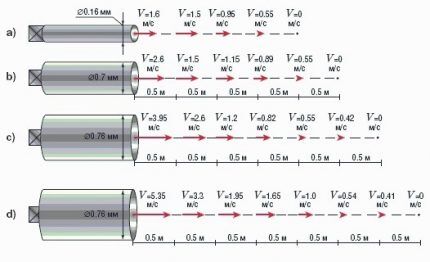
If the thermometer in the apartment shows plus, and at that moment it is minus outside, the internal air rushes out of the room through the ventilation duct upward, because it is lighter and warmer. But as temperatures equalize, the draft in the channel weakens. When, for example, it is +22ºС in the apartment, and +32ºС outside the windows, the less heated internal air remains below and does not go into the ventilation duct.
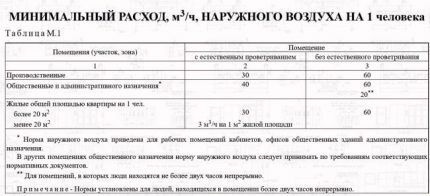
On hot summer days, even absolutely safe natural ventilation stops coping or switches to working in the opposite direction. But this is not a reason to consider it faulty.
In our apartment buildings, supply and exhaust ventilation is installed using the gravitational principle of operation. It works according to the laws of physics; air masses spontaneously enter the premises and are drawn out through the exhaust duct.
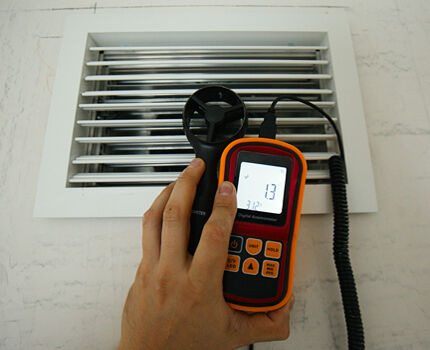
Methods and features fresh air ventilation devices scrupulously analyzed in one of the popular articles on our site.
Reasons for lack of air flow
So, checking the draft showed that the ventilation passages are free, but the air in the apartment stagnates, the kitchen stench and, even worse, the toilet aroma do not disappear.
The thing is that the ventilation of most of our apartments was initially designed to allow fresh air to flow naturally through old wooden window and door structures due to the loose fit of the sashes and the presence of cracks.
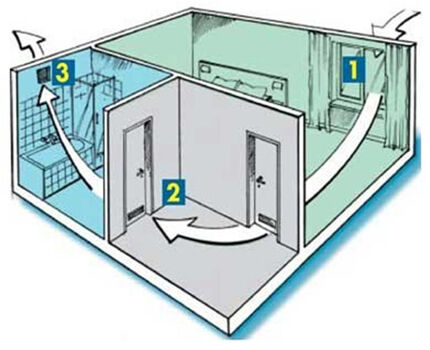
And now completely different high-density building materials, various insulation materials, sealants, and plastic windows are used. We strive to make our homes warm with protection from outside noise and cold, but in the end we block our air flow.
Plastic windows and metal entrance doors clog the room so much that it turns into an airtight one.
Air does not pass through, there is no draft in the ventilation vents. It is especially bad in winter, when the windows are not opened even for ventilation, so as not to chill the rooms. But the problem is easy to solve.
It is enough to open the window a little, and air will begin to flow into the resulting gap. He will walk around the apartment and reach the ventilation holes, which are usually located in the kitchen and bathroom.
Unfortunately, in winter, if we ventilate our homes, it is in a different way. We open all the windows wide at once, but for a short time. At the same time, the air is completely renewed, the apartment does not have time to cool down, but the ventilation still does not work and will not work.
What about in the summer? It will not get better in the summer months, since in winter natural ventilation is forced to work by the difference in temperatures (internal and external), and when these temperatures equalize by summer, the movement of air flows stops.
Troubleshooting ventilation ducts
The first thing that comes to mind is clogged ventilation ducts. Remove the grate from ventilation window and look into it. Garbage found within reach can be raked out manually or collected with a vacuum cleaner.
Removing garbage directly from the ventilation shaft is technically difficult, and this kind of independent action is prohibited for private individuals.
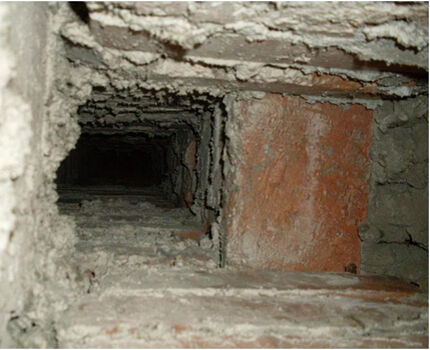
If you suspect obstruction of the ventilation ducts, you should call specialists through the management company, who have the necessary diagnostic instruments and tools.
The debris found contains a lot of construction waste. Unscrupulous builders, when engaged in repairs and redevelopment, often deliberately dump rubbish into the ventilation shaft, without bothering to take it out into the yard.
The result is a blocked ventilation duct. The management company should also be involved in identifying such violations. But even without this, with each successive year of operation, dirt on the walls narrows the lumen of the ventilation duct, and the draft weakens. Dust settles in the ventilation system and cobwebs form. Leaves fly into the mine from above, and birds fall into it.
This is also facilitated by damage that occurs due to shrinkage of the foundation, cracking of walls and other consequences of the inevitable aging of the building. Clogged channels do not cope with the task.
Scheduled audit of ventilation of apartment buildings
Because ventilation ducts are common to the house, their operation is ensured by a management organization, whose representatives are obliged to check the condition of ventilation, and, if necessary, clean the shafts and repair them on the basis of a license or enter into the necessary agreements with specialized companies.
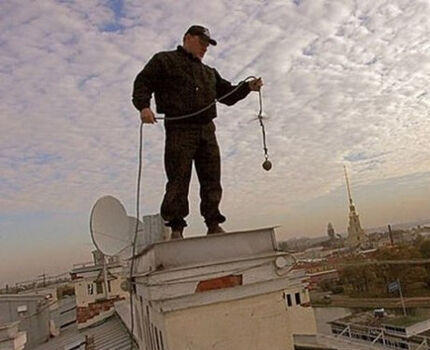
The rules for checking ventilation provide answers to a lot of questions:
- how often are ventilation ducts checked?
- the presence of draft should be checked in apartments or it is enough to inspect only the ventilation shaft;
- Is the frequency of ventilation checks in bathrooms and kitchens the same?
- Is the management organization responsible or is the owner responsible for checking the draft in the apartment?
In apartment buildings, ventilation ducts are checked 1-2 times a year - this depends on whether there are gas appliances or whether only electricity is used. If gas is present, ventilation is checked twice - in summer and winter. If serious problems are identified, use of gas appliances is prohibited until they are corrected.
You cannot arbitrarily alter, repair, or improve ventilation in the apartment, since it is interconnected with the social system. All actions are coordinated with the relevant services.
Problems in the operation of a working system
It happens that ventilation works for a long time, remaining serviceable, and then suddenly stops or begins to blow air in the opposite direction. Indeed, if we discard all the reasons described above, it turns out that the problems with ventilation do not end there.
Let's look at how the natural ventilation of an apartment building with a vertical collection duct works.
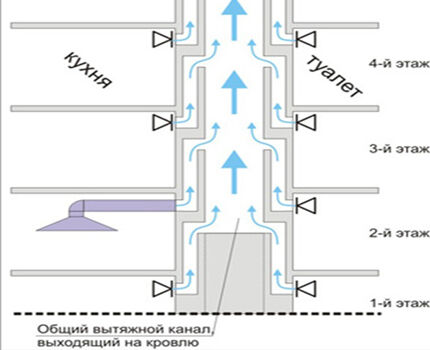
The main ventilation shaft leads from the first floor to the attic. All apartments are equipped with individual ventilation ducts (sleeves or satellite channels).
Each of them rises up one floor from the ventilation vent in a particular apartment and is inserted into the main duct slightly below the same individual ventilation duct belonging to the apartment on the floor above.
The air from the apartment moves through a satellite channel into a common shaft and there it moves further to the attic, and from there to the street. These satellite channels feed the general flow, and if air stops flowing through them, its volume and speed of movement through the main shaft will also decrease.
A hose that stops functioning in one apartment will not disable all ventilation along the riser in a 5, 9, or 16-story building. But the more apartments fall out of the general ventilation system, the weaker it is. Having reached a critical limit, the ventilation fails: the air flow reaching the attic level is so weak that it cannot push itself further.
Moreover, it goes down, and the channels-sleeves of the last two floors are the first to pull it back. To protect the upper floors from reverse draft, individual channels lead directly to the roof. But it is necessary to find out why the flow of air into the ventilation shaft is reduced in individual apartments.
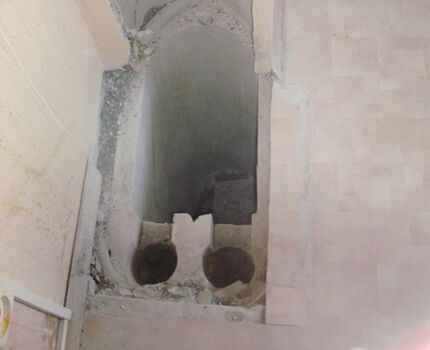
Let's consider a two- or three-room dwelling in which the kitchen and bathroom/toilet are separated at different ends, and therefore two independent ventilation ducts are built. One serves the kitchen, and the other serves the bathroom. This pair of channels pulls stale air from the apartment into the ventilation system, replacing it with fresh air.
Only the air flow from outside is considered correct. The widespread replacement of poor but breathable wooden window frames with double-glazed windows disrupts the circulation process. They do not allow air to pass through; temporarily opening windows for ventilation does not help, since for ventilation to occur, the air flow must be constant.
If the front door does not close so tightly, air may come from the staircase. It is no better in quality than what is in the apartment, but it maintains the viability of ventilation. Although, is there a need for a ventilation system in which the air in the house moves - with the smell of tobacco (they often smoke in the entrance hall), etc.?
When there is no internal air flow through the front door, one of the two ventilation ducts in the apartment (with a stronger draft) will begin to draw air from the second duct. Those. is happening tilting draft in one ventilation duct at the expense of another. The effect is the same - foreign exhaust air in the apartment, a lot of unwanted odors and aromas.
The vagaries of ventilation on the highest floors
In addition to the vertical outlet of the ventilation shaft to the outside, there are other engineering designs of the ventilation system - with a horizontal connecting box in the attic, which has a single exit to the roof, and with a large intermediate ventilation storage compartment, which serves as the attic itself, from where the air moves out through a single common ventilation shaft .
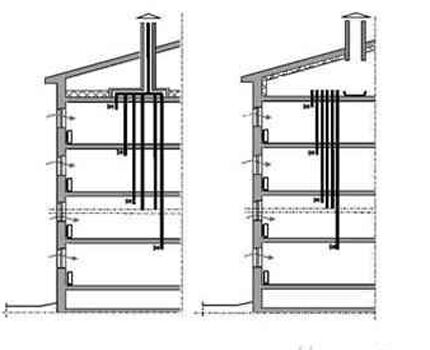
In order for ventilation in apartments on the upper floors to work normally, the air must pass up the vertical shaft at least a few meters, but the attic serves as an obstacle to this, and the following happens:
- in a scheme with a horizontal box – air from all floors reaches the attic level and meets the ceiling of this box along the way. Without turning horizontally, he strives to find other passages, and these often become nearby ventilation hoses of the upper floors;
- in a scheme with access to the attic – in the satellite channels of the upper floors, the air flow does not accelerate enough to flow into the volumetric attic, and the air exchange in the apartments slows down.
In the first case, the ventilation is forced in the opposite direction, and all odors from the lower apartments penetrate to the residents above.Two solutions to the problem are to modernize the connection box, if technically feasible, or to separate the satellite channels of the upper floors from the box, insulate them and lead them directly into the shaft leading to the roof.
In the second case, the draft on the top floors is already weak, and if the attic is ventilated, it can also be reversed. Therefore, the length of the satellite channels on the upper floors is increased, brought to the attic higher and turned towards a common shaft so that the air flow from the lower floors carries with it weaker upper flows.
Cleaning ventilation ducts
As for the main ventilation shaft, private individuals cannot touch it. File a complaint about poor ventilation with the management company and wait for specialists. Before their arrival, you need to notify your neighbors so that they can protect themselves from possible emissions of fine black dust from the ventilation grilles.

Based on the results of the inspection of ventilation ducts, the commission issues a report with instructions for operation and repair.
During the examination, the cross-section of the channels and the length of narrowed areas are measured, paying attention to the condition of:
- shaft walls (cracks, etc.);
- connecting pipes;
- horizontal segments;
- air inlets, heads, hatches, etc.
To clean passages, industrial vacuum cleaners and mechanical devices with various attachments are used. The mine is illuminated by floodlights, and its interior is inspected using digital cameras and video cameras.
Doesn't require much time or expense repair of ventilation ducts. Destroyed sections of the channel are restored by installing metal or ceramic pipes inside, lining them with fastening solutions, and lining them with polymers.
The ventilation duct from the apartment to the common building shaft can and should be cleaned independently:
- move the furniture, remove unnecessary objects, move the stepladder to the wall;
- Below the ventilation hole, glue paper or newspaper to the wall with masking tape so as not to wash off dirt from the wallpaper or tiles, cover the floor;
- remove the decorative grille;
- Wearing gloves, carefully remove dirt and debris from the ventilation duct.
Remove any remaining dirt with a vacuum cleaner, replace the previously washed grille or replace the old one with a new one. After cleaning, check the traction again with the window slightly open.
Methods for optimizing ventilation in an apartment
If the ventilation in the apartment is disrupted due to the installation of sealed double-glazed windows, then use the ventilation mode. We are all familiar with summer ventilation - this is a completely open sash or its position at an angle due to the tilt-and-turn mechanism.
Winter mode is otherwise called micro-slot; to switch to this mode, you need to turn the window handle by 45º with the sash pressed.
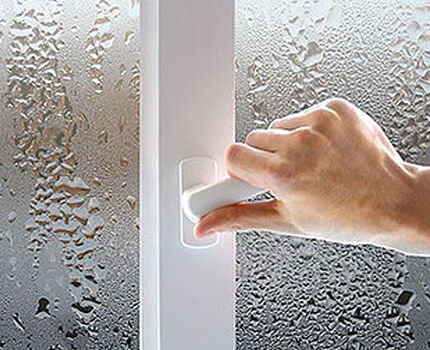
Another way out is to use supply ventilation valves. They are mounted in the external wall, in the joints filled with mounting foam between the window block and the wall, in the window profile, below the window sill.
In winter, there is a slight cold draft from the ventilation valves, but in the hot summer, air may not flow into them at all. Therefore, it makes sense to additionally equip the entrances to the ventilation ducts with exhaust fans.
In the bathroom you have to deal with high humidity. Waterproof fans, built into the ventilation holes, turn on independently, reacting to increased humidity, and turn off when the evaporation evaporates, the air becomes drier.
In toilets, you can install a fan with a motion sensor and timer into the ventilation system. The fan automatically starts spinning when someone comes in and stops after a timer set. In the kitchen, fans with an air quality sensor that detect cigarette smoke and other unwanted odors will be beneficial.
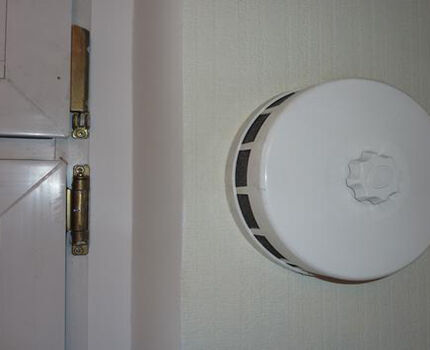
And finally about kitchen hoods. Their power is enough to allow a significant portion of the air in the apartment to pass through during operation. If there is not enough natural air flow, air will inevitably begin to flow back from the ventilation shaft of the bathroom. Limit the use of the hood and open the window slightly when you turn it on.
Conclusions and useful video on the topic
What to do if the ventilation does not work:
As soon as you notice any deviations in the operation of the ventilation system, take action immediately. If you can’t handle it yourself, invite specialists.
If you have any questions while reading the information we have provided, you have valuable information, or you have found flaws in the article, we invite you to comment.Please write comments in the block below.




Poor ventilation is one of the main causes of all kinds of human diseases and a prerequisite for the spread of any unsanitary infection, such as fungus from dampness and the like. I live in an old house, which is about 70 years old, the air does not circulate here even when I do it on my own, and, of course, with the help of specialist friends, I cleaned it, no one cared about this problem. I found the optimal solution - I installed a monoblock ventilation system with air ducts in all rooms, I have four of them). Now everything is fine, the microclimate has been adjusted!
I'd like to see...
There are different stories with ventilation in multi-storey buildings. There are ventilation units that combine exhaust ducts from apartments on adjacent floors in pairs across two floors. If a neighbor has a powerful forced-air hood, then the air flow can completely block the air draft from the other apartment. Therefore, in order to notice this in time, you need to periodically check the operation of the ventilation duct. Previously, everyone used burning matches for this purpose; did this really cause explosions?
Checking ventilation draft with a lit match, candle or lighter is a thing of the past, plus it is not safe. Okay, in living rooms, there’s nothing to burn there other than dust, but dust can also be different. Now let's move smoothly to the kitchen, where almost everyone has a hood.What gets into the ventilation duct along with the air from the kitchen? That's right, these are particles of fat that accumulate there for many years, plus annual dust, and you get an excellent mixture that can ignite not only from a fire, but even from a small spark!
Remember, the easiest and safest way to check the operation of the ventilation is to attach a piece of paper to the hole. If it holds, it means that the ventilation is working properly.
Should I apply a piece of paper with the windows open or closed? with the windows closed, we have reverse draft
We also had a problem with ventilation; there was constant moisture in the bathroom, and fungus began to appear. Although before this 3 years everything was fine. It turned out that our neighbor had tiled the hood in our apartment. And our air stood still, and the ventilation only worked for him. So now we check it ourselves, once a month.
The inspector's idiots... Who initially measured the speed in the grille in the grille itself (which is clogged with dust, as can be seen in the video), without removing it. And then a service that cleans and measures the speed already in the hole (opening) and scratches that it has increased and there is a reserve... Pointing. I'm just laughing...
Your article is suitable for new-built houses, but I need an article for houses from the 70s.
What cross section should the ventilation duct be? Does the channel cross-section affect the operation of the hood? On the 4th floor of a 5-story brick building, my hood is not working well. I installed a ventilation grill last October, and it is still clean, although it should already be dirty.
I didn’t pay attention before, but since July of this year the hood sometimes began to work in the opposite direction.In August it was so windy that I couldn’t light a match or a gas stove. No matter what the Criminal Code has done, things are still there. I started sneezing out of the blue, although I always sneezed only when I had a cold. In the summer my windows are always open. I always open only one window to avoid a draft. So I'm looking for the reasons for the poor performance of the hood!
We live on the 5th floor, 2 small children, neighbors downstairs smoke in the toilet and there is all the smoke in our apartment, there is nothing to breathe at all. He no longer has any strength, the child refused to go to the toilet because he says he is choking on the smoke. You always have to keep the window open, but winter is coming, so what should you do? I do not know what to do.
Hello. Call an authorized person for examination, for example, a district police officer, and then you can submit an application under the article of the Civil Code of the Russian Federation Article 304. Protection of the owner’s rights from violations not related to deprivation of possession to the court, housing inspectorate, Rospotrebnadzor.
For ventilation to work, only two conditions are required: air supply and exhaust. How to organize them is another question. It is important that they match each other. As much as it came out, so much went in. From the lack of one, we get the lack of another.
Hello! What could be the reason for the appearance of dust? Huge layers of dust regularly appear around the perimeter of rooms; wet cleaning only saves for a few hours. Then the dust settles again. We brought a match to both hoods (in the kitchen and in the bathroom), it draws in. There is a check valve in the bathroom. House 2014. From the bathroom and from the kitchen it goes into one shaft
Hello.An unpleasant smell (rotten) appeared in the apartment on the top floor near the front door. I can’t find the source of the stink...could it be coming from the ventilation? old house
Hello, help me figure it out: in a 3-story house on the 3rd floor they turn on the hood above the gas stove, all the smells, fumes and soot are on the second floor. I tried to cope by installing a fan in the ventilation duct, but it didn’t help much. Could installing a fan with a check valve be a solution? Please comment on the situation, if possible, suggest a solution. I will be very grateful
Why might there be two ventilation holes in the kitchen? one hole is blocked, does it make sense to return it? There is currently high humidity in the apartment